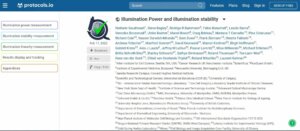In the absence of community Microscopy Metadata guidelines and tools, it is inherently difficult for manufacturers to incorporate standardized configuration information and performance metrics into image data and for scientists to produce comprehensive and harmonized records of imaging experiments. To address this challenge, in 2021, the NIH-funded 4D Nucleome (4DN) initiative Imaging Standards Working Group (IWG), working in conjunction with the BioImaging North America (BINA) Quality Control and Data Management Working Group (QC-DM-WG), proposed flexible microscopy metadata specifications for light microscopy
Join QUAREP WG7 (Metadata) NBO-Q Harmonize the description of light microscopy hardware, acquisition settings, and quality-control metrics in order to enhance image quality, reproducibility, and to fulfill the FAIR (Findable, Accessible, Interoperable, and Reusable) data principles. Microscopy metadata is essential for image data QC, interpretation, analysis and sharing. Purpose Promote the harmonized generation and pre-publication management of image datasets from the ground up. Facilitate the deposition of microscopy datasets to public image data repositories (e.g., BioImage Archive, OME-Image Data Resource,
NBO-Q empowers imaging scientists! Imaging Scientists benefit from these standards that provide a clear, community-driven framework for recording the metadata that matters most—from sample preparation and imaging conditions to microscope hardware and acquisition settings. By adopting NBO-Q in your workflows, you ensure that your image data is not only reproducible and high quality but also compliant with FAIR principles, making it easier to share, publish, and reanalyze. The NBO-Q community is actively working to enable easy integration with tools like
NBO-Q is built for developers! NBO-Q provides a structured, community-agreed metadata framework for light microscopy, making it easier to build tools that ensure reproducibility, quality control, and interoperability. By aligning with NBO-Q, developers can create applications that integrate seamlessly with emerging standards like OME-Zarr and tools like Micro-Meta App, supporting FAIR data practices and accelerating scientific discovery.
NBO-Q is for Developers Developers NBO-Q provides a structured, community-agreed metadata framework for light microscopy, making it easier to build tools that ensure reproducibility, quality control, and interoperability. By aligning with NBO-Q, developers can create applications that integrate seamlessly with emerging standards like OME-Zarr and tools like Micro-Meta App, supporting FAIR data practices and accelerating scientific discovery. Developers NBO-Q provides a structured, community-agreed metadata framework for light microscopy,making it easier to build tools that ensure reproducibility, quality control, and interoperability.
In April 2025, Yury Belyaev from the Microscopy Imaging Center (MIC) at the University of Bern, and a member of QUAREP-LiMi Working Group 5 (WG5), visited the Central Analytical Facilities (CAF) Microscopy Unit at Stellenbosch University, South Africa, as part of the Global BioImaging (GBI) International Job Shadowing Program During his visit, Yury Belyaev collaborated with Lize Engelbrecht, manager of the CAF Microscopy Unit, to organize a hands-on microscopy workshop. The training covered wide-field and confocal microscopy, image analysis, and
WG11, as part of its mission to enhance publication standards for reproducible image-based science and in response to an inquiry from Nature Methods, has defined the “Bare Minimum Requirements for Microscopy Methods Reporting“. This checklist, built upon the REMBI framework and the NBO-Q metadata model, is designed to guide researchers, scientific journals, and editors in the peer-review process, ensuring that microscopy methods across most applications include sufficient details for reproducibility.
©Copyright Einstein Foundation, Sebastian Gabsch On Friday, 14.03.2025, Helena Jambor and Christopher Schmied of Quarep-LiMi WG12 were honored at the annual award ceremony of the Einstein Foundation Berlin, held at the Museum Bode in Berlin. They received the Einstein Foundation Early Career Award for promoting research quality with their project: “PixelQuality – Best practices for publishing images.” The Early Career Award comes with a prize of EUR 100,000. Other award recipients included the platform PubPeer for the Institutional Award and
In 2024, QUAREP-LiMi took a significant step forward by developing its By-Laws. Version 1.0 of the QUAREP-LiMi By-Laws has now been published on Zenodo. You can view and download them here:: https://zenodo.org/records/14884071
On March 13, 2025, Einstein Foundation Early Career Award winners Helena Jambor and Christopher Schmied, along with Elisabeth Bik and Brandon Stell, will host a colloquium titled “From Detection to Prevention: Improving the Scientific Publication Record Through Error Detection, Post-Publication Peer Review, and Image Guidelines.” The event will be available both online and in person. For more information and to register, visit: https://www.einsteinfoundation.de/en/insights/events/award/2024-einstein-foundation-award-winners-colloquium

WG 1 – Illumination Power published its third version of the protocol “Illumination Power, Stability and Linearity Measurements for Confocal, Widefield and Multiphoton Microscopes”. The protocol is featured on protocols.io
We rely on decentralized short message services. Therefore QUAREP-LiMi is now on Bluesky. Furthermore we are leaving X (#eXit). The account will remain visible as an archive, there will be no new tweets.
The WG 2 released its first protocol “Characterization of the Photon Conversion Factor, Noise, and Dynamic Range of Light Microscope Detection Systems“. In total there are 5 protocols belonging to the protocol: Introduction – Background and Aims Sample Preparation – An Easy-to-Prepare Sample Slide Data Generation – Systems with an Area Detector Data Generation – Systems with a Point Detector Analysis – Characterization of the Photon Conversion Factor, Noise, and Dynamic Range The protocols are featured on